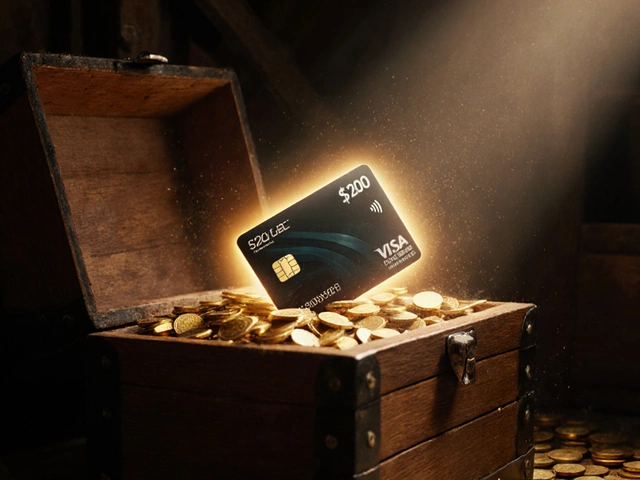
Ever get a personal loan offer and wonder if that 7% rate is something to brag about—or run from? You’re not the only one scratching your head. Loan rates can look simple on paper, but a lot is going on behind those numbers. What counts as a good rate changes fast, especially now that interest rates are bouncing around more than ever.
Take a look at what banks and online lenders are offering right now. Some people with top-notch credit are snagging personal loans at rates as low as 6%—sometimes even less if you luck out with a promo. But that’s not the average story. Most borrowers see rates anywhere from 8% to 14%, especially if their credit score isn’t squeaky clean. So, a 7% rate might actually put you ahead of the game, but it all depends on your situation and what’s going on in the market this month.
- What’s Considered High or Low for Personal Loan Rates?
- How Lenders Set Your Rate
- What 7% Really Means for Your Wallet
- How to Lower Your Rate
- When Is 7% Actually a Good Deal?
What’s Considered High or Low for Personal Loan Rates?
Personal loan rates cover a huge range, and what’s “high” or “low” changes every year. It’s all about timing and your own financial profile. Right now, as of May 2025, here’s how things break down for most folks shopping around in the U.S.:
| Credit Score Range | Typical Interest Rate |
|---|---|
| Excellent (720+) | 6% – 10% |
| Good (690–719) | 9% – 14% |
| Fair (630–689) | 12% – 19% |
| Poor (<630) | 18% and up |
Now, that’s national averages. Some credit unions still sneak in offers below 7% if your credit is strong and you’re a member, but anything under 8% is solid for most people today. On the flip side, if you’re seeing rates over 15%, it usually means your credit needs work or you’re dealing with a lender who specializes in risky loans.
Here's what actually affects where you fall on this chart:
- Credit score – The biggest factor by far. Higher scores mean lower rates.
- Income and debt – Lenders look at how much you owe versus what you make.
- Loan size and term – Smaller loans and shorter payback times tend to get better rates.
- Where you shop – Online lenders, banks, and credit unions each have their own pricing.
If you spot a personal loan rate that’s way higher than what’s on the table above and your credit score is decent, don’t just take it. Shop around. Offers can vary by as much as 5% from one lender to the next, even for the same person.
How Lenders Set Your Rate
Wondering why two people can apply for the same loan but get wildly different offers? Lenders don’t just roll the dice—they look at a bunch of factors to figure out what rate you’ll pay. Here’s what they check before landing on that number:
- Credit Score: This is the big one. A top-tier credit score (think 750 and up) can open the door to the lowest interest deals. Drop below 700, and you’ll usually pay more.
- Income and Job History: Steady income and a solid track record at work tell lenders you’re less risky. If you can prove you’re bringing in regular paychecks, you’re more likely to snag a low rate.
- Debt-to-Income Ratio (DTI): This is just your monthly debts divided by your monthly income. Lenders like to see a DTI under 36%. The lower it is, the better your shot at scoring a decent rate.
- Loan Amount and Term: Asking for more money or stretching payments out over a lot of years? That can bump up your rate because there’s more risk for the bank if you take longer to pay them back.
- Loan Purpose: Some lenders care what you’re using the money for. Debt consolidation loans sometimes get better rates than, say, a loan for a big vacation.
Check out this table with average personal loan rates by credit score so you can see where you might land:
| Credit Score Range | Average Personal Loan Rate (2024) |
|---|---|
| 760 and higher | 6.5% |
| 700 - 759 | 10.2% |
| 640 - 699 | 17.8% |
| Below 640 | 24% and up |
Here’s a tip: Always check your credit before applying. Even small score improvements can knock your rate down a few notches. And if a lender only ever talks about your monthly payment, ask for the full story—including your personal loan rate. That’s where the real cost lives.

What 7% Really Means for Your Wallet
So what does a 7% rate actually do to your monthly payments? Let’s get real with some numbers. Say you borrow $10,000 for a 3-year term. At 7%, you’re looking at monthly payments around $309, and you’d pay roughly $1,130 in interest over the life of the loan. If your rate was 12% instead, that same loan would bump your payment up to about $332, and you’d shell out almost $1,950 just in interest. That’s a difference of over $800, just because of the rate.
| APR | Monthly Payment | Total Interest Paid |
|---|---|---|
| 7% | $309 | $1,130 |
| 12% | $332 | $1,950 |
That table spells it out for you. A few percentage points can easily add up to hundreds—or even thousands—over time.
Here’s another thing: that 7% rate isn’t just a random number pulled out of thin air. Lenders set rates based on risk, and a 7% offer usually means you’ve got a decent credit profile. If your credit score falls in the 700s or higher, you’re more likely to qualify for anything near that number. But if you dip into the 600s or lower, brace yourself for higher rates.
Think about your monthly budget, too. Lower rates free up more of your paycheck for things you actually care about instead of tossing that extra cash into the lender’s pocket. Before you sign, use an online loan calculator to plug in your numbers. Even a small rate drop can mean real savings.
A lot of people don’t realize it, but fees matter just as much as the rate. Some loans advertise a personal loan rate of 7%, but sneak in origination fees or early payment penalties. Always check the APR—the real cost after fees—to avoid any expensive surprises.
How to Lower Your Rate
Cutting your personal loan rate doesn’t have to be a mystery. Lenders use a few predictable things to set your rate, and you’ve got some control over most of them—especially if you plan ahead. Here’s how you can actually move the numbers in your favor before you sign anything.
The first step: check your credit score. Most lenders use this as their main guide, and the numbers matter a lot more than people suspect. Even a 20-point bump can nudge your annual percentage rate (APR) down by a full percent or more. According to FICO, folks with scores above 760 usually snag the best deals, sometimes beating out the rates banks show in ads.
- Pay down existing debt: Lenders peek at your debt-to-income (DTI) ratio. If too much of your paycheck is already tied up, you’ll get dinged. Paying off a credit card or bumping up your monthly payment can help right before you apply.
- Shop around: Don’t assume your current bank is the cheapest. Online lenders, credit unions, and local banks sometimes undercut big banks by a full percent or two—especially if you compare offers within 30 days (it counts as a single credit inquiry on your report).
- Add a co-signer: If your credit score isn’t where you want, a co-signer with better credit can drag your rate down. Lenders spread the risk, so you both win on the numbers.
- Choose a shorter term: The longer you stretch out your loan, the more risk for lenders, and the higher the rate. If you can handle bigger monthly payments, a 3-year term is often cheaper than a 5-year term.
- Set up auto-pay: A surprising fact—a lot of lenders (like LightStream and SoFi) give about a 0.25% discount just for letting them take payments out automatically. It’s easy, free, and stacks with other discounts.
Check out this example to see how even a small dip can affect what you pay in the end:
| Loan Amount | Term | Rate | Monthly Payment | Total Interest Paid |
|---|---|---|---|---|
| $10,000 | 3 years | 9% | $318 | $1,448 |
| $10,000 | 3 years | 7% (personal loan rate target) | $309 | $1,123 |
That extra 2% costs over $300 more, just on a $10,000 loan. So every tenth of a percent really counts. Take a few of these steps, and you could save some serious cash in the end.

When Is 7% Actually a Good Deal?
Here’s the thing about personal loans: “good” is pretty much always relative. If you flash back to 2022 and early 2023, average personal loan rates in the U.S. were about 9.5% to 11% according to Federal Reserve data. Now, with the economy shifting and the Fed playing with rates, seeing offers at 14% or even higher is common for a lot of folks. So, if a lender is willing to give you personal loan funds at 7%, that could be a win, depending on what’s stacked against you.
You’re more likely to land a 7% rate and actually call it a win in the following cases:
- Your credit score isn’t perfect. Got a score under 750? Most lenders are going to offer you something above 7%. So, if you get 7% with a score in the 690–750 range, you’re doing better than average.
- You need the money for something big and have limited options. Maybe credit cards are flashing 19% interest or even higher—7% beats that by miles.
- Market rates are just high. If the average personal loan rate on the market is above 10%, locking in a 7% deal is actually solid.
- You want a fixed payment schedule. Personal loans are usually fixed-rate, so there are no surprises, unlike variable credit cards or lines of credit.
If you’re super curious how 7% stacks up versus other rates, check out the table below. It shows what you’ll pay in interest (ballpark) on a $10,000 loan for various rates over three years:
| Interest Rate | Total Interest Paid (3 Years, $10K Loan) |
|---|---|
| 6% | $957 |
| 7% | $1,112 |
| 9% | $1,432 |
| 12% | $1,934 |
So, if your choices are 7% or anything above it, you’re saving hundreds in the long run. Always compare offers, but if you lock in 7% while others are stuck with double digits, you’ve made a savvy move for your wallet.







Write a comment